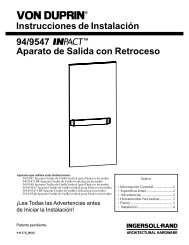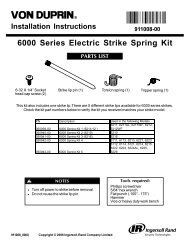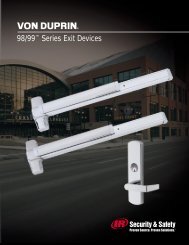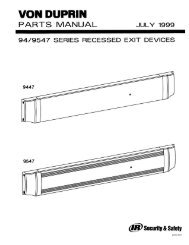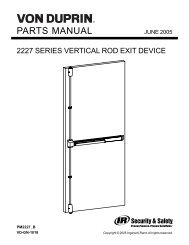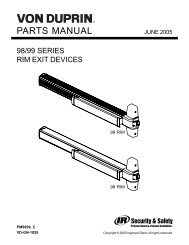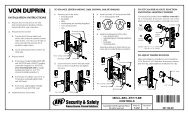Fire, Life Safety & Accessibility Codes - Von Duprin
Fire, Life Safety & Accessibility Codes - Von Duprin
Fire, Life Safety & Accessibility Codes - Von Duprin
Create successful ePaper yourself
Turn your PDF publications into a flip-book with our unique Google optimized e-Paper software.
De-Coding Delayed Egress Hardware<br />
Delayed egress hardware prevents a door from being opened from<br />
the egress side, usually for a period of 15 seconds. This type of<br />
device is often used to prevent theft, while maintaining life safety.<br />
The system is most commonly comprised of an exit device<br />
incorporating delayed egress features, or an electromagnetic lock<br />
and power supply, one of which would contain delayed egress<br />
circuitry. When the device is actuated, the door remains locked on<br />
the egress side for 15 seconds, and then releases to allow egress.<br />
Requirements of NFPA 101® The <strong>Life</strong> <strong>Safety</strong> Code® and NFPA<br />
5000 Building Construction and <strong>Safety</strong> Code:<br />
The 2006 editions of NFPA 101® (section 7.2.1.6.1) and NFPA<br />
5000 (section 11.2.1.6.1) state the following requirements for<br />
delayed egress locks. All of these requirements must be met.<br />
· The building must be protected throughout by an approved,<br />
supervised automatic fire detection system or an approved,<br />
super vised automatic sprinkler system, installed in accordance<br />
with the applicable section.<br />
· Delayed egress locks must be approved and listed, and must be<br />
permitted by the individual occupancy chapters, low and ordinary<br />
hazard content areas only (refer to Table 1 for occupancies and<br />
conditions for use).<br />
· Devices must release immediately (no delay) upon actuation of<br />
the sprinkler system, any heat detector, or not more than two<br />
smoke detectors of the fire detection system, and loss of power<br />
to the lock.<br />
· Devices must release 15 seconds after a force of 15 pounds is<br />
applied for a maximum of 3 seconds (the code official may<br />
increase the delay from 15 to 30 seconds). The initiation of the<br />
15-second cycle must be an irreversible process.<br />
· An audible local alarm must sound upon initiation of the<br />
release process.<br />
· The system must be rearmed manually.<br />
· Signage must be provided on the door adjacent to the release<br />
device stating “PUSH UNTIL ALARM SOUNDS. DOOR CAN BE<br />
OPENED IN 15 SECONDS.” Letters must be 1˝ (25 mm) minimum<br />
in height, with a stroke width of 1/8" (3.2 mm) minimum, on a<br />
contrasting back-ground. If the code official has permitted an<br />
increase of the operation time, the sign must state the<br />
appropriate time.<br />
· Emergency lighting is required (this requirement is located in<br />
section 7.9.1.1 / 11.9.1.1).<br />
· Several occupancies, as well as several of the other referenced<br />
codes, require that a building occupant may not encounter more<br />
than one delay in a means of egress.<br />
Notable differences in other codes:<br />
Most of the referenced codes have similar requirements to those of<br />
NFPA 101® and 5000, but there are some important differences.<br />
One major difference between codes is the occupancy types or use<br />
groups where delayed egress hardware may be used (Table 2).<br />
For example, while NFPA 101® and 5000 do not restrict the use<br />
of delayed egress hardware on doors in Assembly Occupancies<br />
(other than the main entrance/exit), none of the other referenced<br />
codes permit the use of delayed egress hardware on any egress<br />
doors in Assembly Occupancies. Libraries, which are a great<br />
application for delayed egress hardware, are defined by most codes<br />
as Assembly Occupancies, so delayed egress hardware may be<br />
prohibited. Also note that neither the IBC nor the UBC allow delayed<br />
egress hardware to be used in Educational Occupancies, while NFPA<br />
101®, NFPA 5000, BOCA, and SBC do allow the use of delayed<br />
egress hardware in Educational Occupancies.<br />
Another difference between code requirements is the manner in<br />
which the delayed egress system may be initiated and rearmed.<br />
Table 3 illustrates these differences. The amount of time that force<br />
must be applied before the 15-second cycle begins is important<br />
because delayed egress hardware that has been designed to meet<br />
NFPA 101® requirements (3-second application of force) may need<br />
factory modifications to meet the other codes. Rearming the<br />
delayed egress hardware refers to “resetting” the device. Several<br />
codes require the device to be manually rearmed by a person going<br />
to the door to reset the device. Other codes allow the device to<br />
automatically rearm itself after the door has been opened, and in the<br />
case of BOCA, only after the door has opened, closed, and remained<br />
closed for 30 seconds. For some delayed egress hardware, this would<br />
require that a door position switch be added to the system.<br />
Several codes state that the delayed egress device must be able to<br />
be released by a signal from a remote location. BOCA requires that<br />
the signal originate from an emergency control station, which is “an<br />
approved location on the premises where signals from emergency<br />
equipment are received and which is staffed by trained personnel.”<br />
Per the IBC, the signal must originate from the fire command center.<br />
The UBC requires the signal switch to be in an “approved location.”<br />
Table 1: Occupancies Permitting Delayed Egress Locks NFPA<br />
101 & NFPA 5000, 2006 Editions<br />
Occupancy Condition<br />
Assembly Only doors other than main<br />
entrance/exit doors may be<br />
equipped with delayed egress locks.<br />
Educational, Day Care No restrictions<br />
Health Care<br />
Lodging and Rooming Houses Not more than one delayed egress<br />
Hotels and Dormitories device may be encountered<br />
Apartment Buildings in any egress path.<br />
Exterior doors only. Not more than<br />
Residential Board and Care one delayed egress device may be<br />
encountered in any egress path.<br />
No restrictions (Editions of NFPA<br />
Ambulatory Health Care 101 prior to 2003 limit the use of<br />
delayed egress devices in<br />
ambulatory health care occupancies<br />
to exterior doors.)<br />
Mercantile, Business, No restrictions<br />
Industrial, Storage<br />
32 877.840.3621 • www.securitytechnologies.ingersollrand.com



